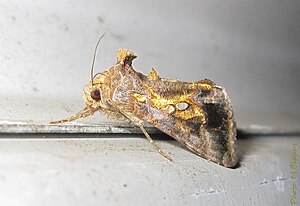Chrysodeixis chalcites
| Chrysodeixis chalcites | ||||||||||||
|---|---|---|---|---|---|---|---|---|---|---|---|---|

Chrysodeixis chalcites |
||||||||||||
| Systematics | ||||||||||||
|
||||||||||||
| Scientific name | ||||||||||||
| Chrysodeixis chalcites | ||||||||||||
| ( Esper , 1789) |
Chrysodeixis chalcites , sometimes also known as the tomato gold owl or Turkish moth , is a butterfly ( moth ) from the family of the owl butterfly (Noctuidae).
features
butterfly
The wingspan of the moth is 32 to 42 millimeters. On the front wings reddish brown stains prevail. They show two characteristic, silver-white, closed, teardrop-shaped characters that are close to each other, but do not merge with each other. The lower middle field and the fringing field are darkened and mostly covered with golden brown dust. The outer transverse line is strongly jagged. The hind wings are gray-brown without drawing, somewhat darkened at the edge. The thorax is furry and has a few tufts of hair, the proboscis is well developed.
Egg, caterpillar, pupa
The eggs have a yellowish color and are covered with many longitudinal ribs.
Adult caterpillars are green in color. They have thin whitish back and side back lines as well as wide, also whitish side stripes.
The pupa is yellowish, greenish or brownish in color and shows light segment incisions as well as black-brown back parts and brown wing sheaths.
Similar species
- The overall appearance of the iota silver owl ( Autographa jota ) is more pink-brown in color, while the Ziest silver owl ( Autographa pulchrina ) is more purple-brown in color. In the butterflies of both species , the front silver mark is open upwards in a V shape.
- Chrysodeixis acuta is paler and more gray-brown in color.
The butterflies of all the aforementioned species lack a golden-brown over-dusting of the front wings.
distribution and habitat
Chrysodeixis chalcites occurs in the Mediterranean area and in large parts of Africa. It was also proven in the Lake Garda area . Information from Asia and Australia requires confirmation and may relate to Chrysodeixis eriosoma . The species is native to many different biotopes , but particularly likes to colonize cultural landscapes.
Way of life
The moths of Chrysodeixis chalcites form consecutive generations. They are mostly nocturnal and also visit bait and artificial light sources . The caterpillars prefer to feed on the leaves of various crops, for example tomatoes , potatoes , tobacco , corn and alfalfa . In North America the species was introduced into greenhouses and occurs there as a pest every year .
Danger
The species is not native to Germany. Occasionally she wanders and is found a stray visitor. However, it is not a classic migratory butterfly . The introduction of vegetables is also possible.
swell
Individual evidence
- ↑ a b Barry Goater, Lázló Ronkay and Michael Fibiger: Catocalinae & Plusiinae Noctuidae Europaeae, Volume 10. , Sorø 2003 ISBN 87-89430-08-5
- ↑ Josef Wolfsberger: "The large butterfly fauna of the Lake Garda area." Journal of the Vienna Entomological Society 45 year 1960
- ^ A b Günter Ebert: The Butterflies of Baden-Württemberg Volume 5, Moths III. Ulmer Verlag Stuttgart 1997. ISBN 3-8001-3481-0
- ↑ Pacific Northwest http://pnwmoths.biol.wwu.edu/browse/family-noctuidae/subfamily-plusiinae/tribe-argyrogrammatini/chrysodeixis/chrysodeixis-chalcites/
- ↑ The Canadian Entomologist http://journals.cambridge.org/action/displayAbstract?fromPage=online&aid=8913617
- ↑ Federal Agency for Nature Conservation (Ed.): Red List of Endangered Animals in Germany . Landwirtschaftsverlag, Münster 1998, ISBN 3-89624-110-9 .
literature
- Barry Goater, Lázló Ronkay and Michael Fibiger: Catocalinae & Plusiinae Noctuidae Europaeae, Volume 10. , Sorø 2003 ISBN 87-89430-08-5
- Walter Forster , Theodor A. Wohlfahrt : The butterflies of Central Europe. Volume 4: Owls. (Noctuidae). Franckh'sche Verlagshandlung, Stuttgart 1971, ISBN 3-440-03752-5 .
Web links
- Lepiforum e. V. - Taxonomy and photos
- www.euroleps.ch - photos
- www.nic.funet.fi - dissemination
- www.schmetterlinge-deutschlands.de - endangerment
- Chrysodeixis chalcites at Fauna Europaea. Retrieved November 9, 2013
